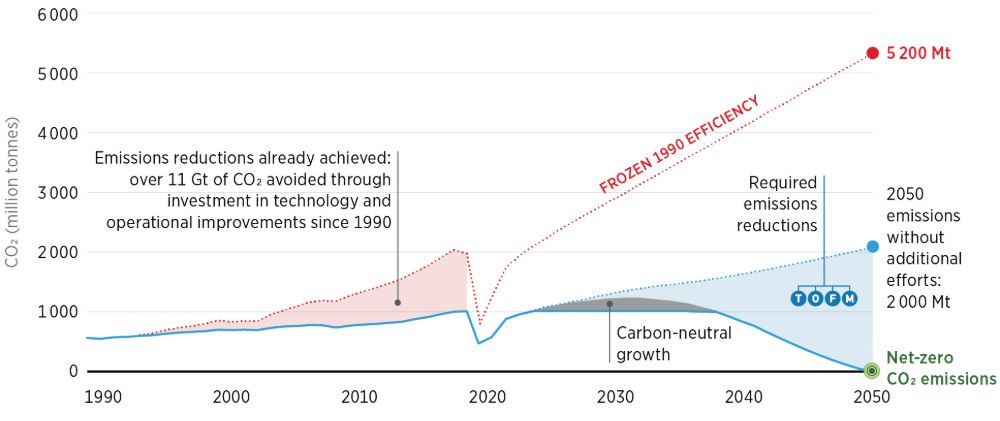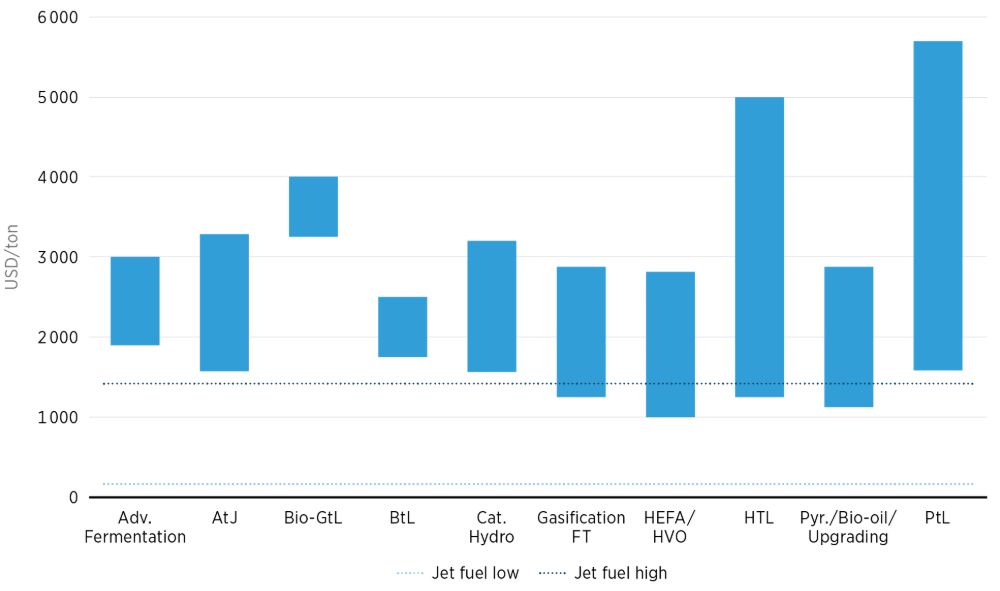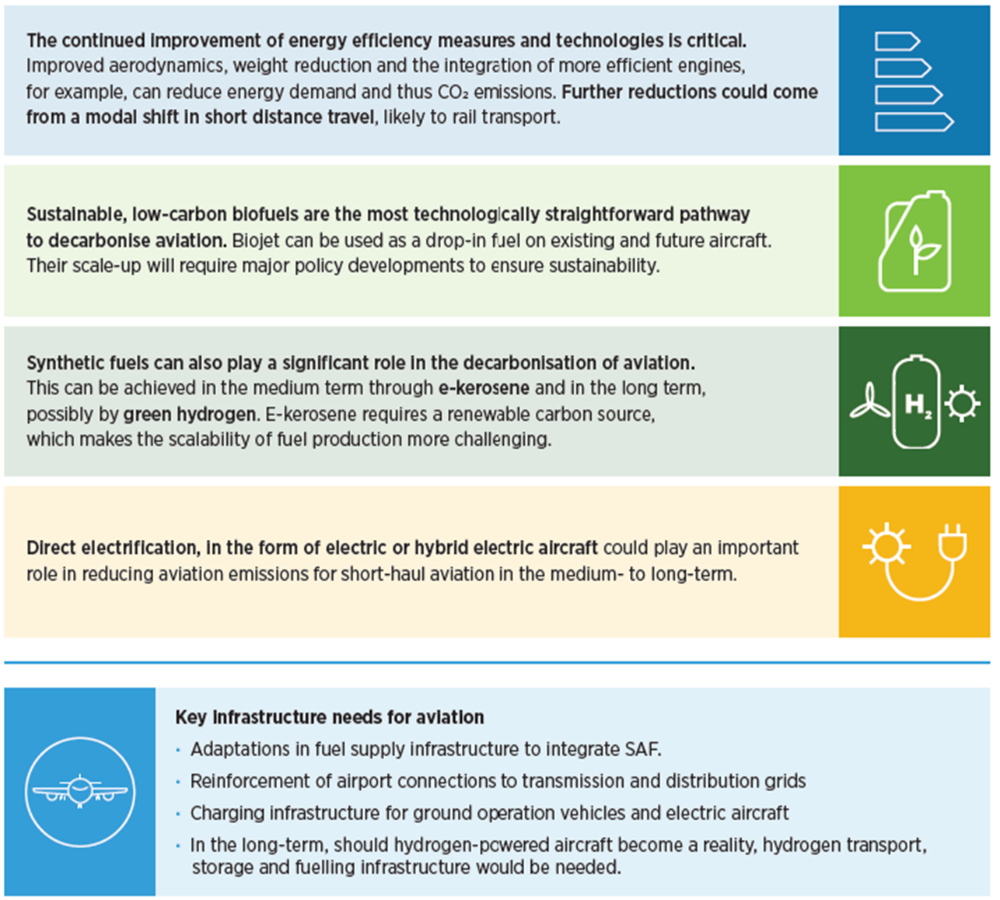2.3 Aviation
Aviation plays a vital role in connecting people, enabling global business, facilitating international trade and tourism, and providing a means of rapid transportation. The sector drives economic growth, shortens travel times and increases global interconnectedness.
One of the main challenges faced by aviation, however, is providing its social and economic benefits while also increasing its environmental responsibility. As one of the most carbon-intensive transport modes, aviation is a significant contributor to global GHG emissions and climate change (DESNZ and BEIZ, 2022). The sector is also responsible for non CO2 emissions (i.e. other gases and aerosol particles) that affect both the atmospheric composition and cloudiness, adding to the impact of the sector’s CO2 emissions (Lee, 2018).
In recent decades, demand for aviation services has steadily grown and could double by 2050 compared with 2022 levels (Graver, 2022; IATA, 2023). Therefore, there is a need to rapidly deploy decarbonisation solutions.
Emissions and energy use
In 2023, the energy consumption of the global aviation sector reached 13 EJ. This equates to 10% of the world’s transport-related energy consumption and 3% of total global energy consumption (IEA, 2024a). This energy demand was met nearly exclusively by fossil fuels. Sustainable aviation fuel (SAF) production is expected to reach 2.1 million litres in 2025, representing just 0.7% of total jet fuel production (IATA, 2024).
Dependency on fossil fuels results in aviation contributing significantly to the world’s CO2 emissions and climate change. CO2 emissions from aviation in 2022 reached 0.9 Gt, equivalent to between 2% and 3% of global emissions and 11% of all transport-related emissions (IEA, 2023a). Growth in aviation emissions has been continuous, but it has been partially offset by substantial efficiency improvements. As shown in Figure 10, these improvements have resulted in as much as 11 GtCO2 in emission reductions since 1990 (ATAG, 2021). In addition to carbon emissions, aviation contributes to climate change through the formation of contrails.
Figure 10: Historical and projected CO2 emissions of the aviation sector, 1990-2050

Due to the mass and volume limitations of aircraft, aviation depends on highly energy-dense fuels. There are sustainable fuel alternatives, but these come with a cost premium. The limited choice of usable fuels and the immaturity of alternative aircraft technologies, such as electric or hydrogen-powered aircraft, therefore limit the decarbonisation pathways available to the sector.
Decarbonisation pathways
One decarbonisation pathway for aviation is the continued deployment of technological and operational energy efficiency improvements. Although the aviation sector has made significant progress in deploying increasingly efficient airframes and engines, there is still potential for further improvement. The International Civil Aviation Organization (ICAO) long-term aspirational goal aims for a 2% increase in fuel efficiency annually until 2050. This is higher than the average historically observed, and other projected, improvements of just 1.5% per year (ICAO, 2022a).
According to IRENA’s 1.5°C scenario, demand reduction and energy efficiency improvement are an important part of the sector’s decarbonisation efforts. These measures could account for roughly half of the sector’s emission reductions by 2050 13 (IRENA, 2023c). Further reductions could come from modal shifts in short-distance air travel – for example, replacing short flights with trains, which are much less carbon intensive (European Environment Agency, 2023).
The most technologically straightforward pathway to decarbonise the sector, however, is the use of advanced biofuels, namely biojet, given the maturity of the technology. Biojet can be used as a drop-in fuel on existing and future aircraft, making it a practical and immediately implementable option. Long-term bioenergy potential is not a constraint for the transition of the sector, either. IRENA suggests that the global technical potential for sustainable advanced biofuels is at least 114 EJ (IRENA, 2016b) or roughly eight times the energy demand for aviation. Current global biofuel production is only around 4.5 EJ, however, and is mostly food and feed crop based (90%) and used mainly for road transport (OECD/FAO, 2023).
The main challenges with biofuel are, first, its higher cost compared with conventional jet fuel and, second, the need to scale up its supply sustainably. Indeed, the rapid scale-up of sustainable biomass is complex and cannot be achieved without careful consideration of its potential negative impacts, particularly in terms of land use change and life-cycle GHG emissions. Minimizing these impacts requires strict controls along the entire supply chain, robust certification mechanisms and substantial policy interventions in the agriculture sector. At the same time, the increasing electrification of road transport could allow biofuel production capacity to be redirected towards other sectors, such as aviation and shipping.
Another option is the adoption of synthetic fuels produced from green hydrogen, which is produced from electrolysed water using renewable electricity. This can then be combined with a renewable source of carbon to produce a hydrocarbon fuel. The two options currently being considered are green hydrogen and e-kerosene. Although hydrogen could eliminate exhaust emissions from aviation, hydrogen aircraft technology for large passenger or cargo transport does not exist yet. This technology is also not expected to reach commercial maturity within a time frame compatible with making a material impact on carbon neutrality by mid-century. A fundamental issue revolves around the low volumetric energy density of hydrogen, which would require a fundamental redesign of airframes as well as operational procedures and safety standards. Furthermore, there is no hydrogen refuelling infrastructure in place.
E-kerosene, on the other hand, is chemically identical to its fossil counterpart and could be used in existing aircraft. The use of e-kerosene opens the door for deep emission reductions. However, the fact that the e-kerosene molecule contains carbon adds a layer of complexity. For e-kerosene to be an effective decarbonisation solution, it would have to be low carbon, and this carbon would need to come from a sustainable source (i.e. from biogenic sources such as bioenergy with CO2 capture or captured directly from the atmosphere). The need to build a sustainable supply chain for carbon is a major challenge, particularly given that to achieve cost efficiency, cheap renewable electricity for hydrogen production and a sustainable (and scalable) carbon source would need to be available.
However, if these challenges can be met, biofuels and e-fuels could account for the remaining half of the CO2 reductions needed by 2050, under IRENA’s 1.5°C scenario.
Figure 11: Production cost comparison of sustainable aviation fuels

Source: IRENA, 2021b; WEF, 2020.
Electric propulsion is another technology pathway that should be considered for aviation. In the past, this has had limited potential as a decarbonisation solution due to the limited energy density of commercially available batteries. However, there has been remarkable progress in battery technologies over the last few years. Breakthroughs in energy density, with some batteries reaching 500 Wh/kg, could open the door the application of such batteries in electric or hybrid small aircraft and short-haul flights (CATL, 2023).
Electric propulsion also offers potential advantages over jet engines in areas such as higher efficiency, lower mechanical complexity and maintenance costs. Yet this pathway is not without its challenges. These challenges include the need to develop and certify new aircraft concepts and the need for further research and development in battery technologies to make them viable for flight as well as ground operations. These challenges also limit the decarbonisation potential of this technological pathway, given that new aircraft concepts can take as long as a decade to be developed and certified (FAA, 2023).
Figure 12: Summary of decarbonisation pathways for aviation
